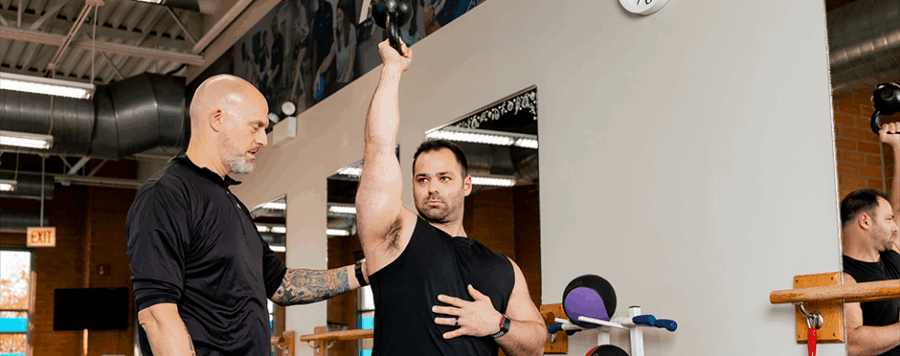Spinal Mechanics in Throwing
The thoracic spine plays an important role in a combination of movements during throwing. The facet joint of the vertebra is capable of flexing and extending. When both sides move forward together, the motion is flexion, and, conversely, when they move backward, the motion is extension. They can also move in opposite directions, producing rotation or side bending.
Rotational and side-bending movements are pivotal within the throwing motion and must be combined for normal throwing mechanics and to decrease stress on the shoulder and elbow. Deficits within the spine during throwing motions will cause increases in stress on the shoulder and elbow.
Rehabilitation of the Overhead Athlete
Physical therapy can be especially helpful in restoring standard spine mechanics and control in overhead athletes. Spinal mobilization and manipulation are highly effective in decreasing pain and increasing mobility at the shoulder and elbow in overhead athletes. Once the athlete is able, tissue tone and strength must be addressed to restore standard neuromotor control.
For muscles surrounding the scapula (shoulder blade), exercises between 60-180 degrees of flexion are optimal. When specifically addressing neuromotor control with these muscle groups, performing a minimum of 30 consecutive repetitions with 6-8 second isometric holds is ideal. As the athlete progresses toward strength training, these exercises and movements need to become more throwing-specific, and muscle groups need to be worked to fatigue for hypertrophy to occur.
Physical Therapy Examination and Treatment
Due to the specific demands of the spine with the overhead throwing motion, a physical therapist is often an excellent starting place when experiencing pain or dysfunction as an overhead athlete. Physical therapy will examine the irritated areas of the shoulder or elbow and determine contributing factors from other body regions, such as the spine. The physical therapist will be able to correct deficits to assist in the recovery timeline and target specific muscle groups with exercise techniques designed to improve control and strength during throwing. The overhead throwing motion is a complex, total body, rotational movement in which the spine plays an important role and should be assessed with any overhead athlete who is experiencing pain or dysfunction. Connect with an overhead specialist today to improve your game!
*Per federal guidelines, beneficiaries of plans such as Medicare, Medicaid, Tricare, VHA and other federally funded plans are not eligible for free assessments.
The Athletico blog is an educational resource written by Athletico employees. Athletico bloggers are licensed professionals who abide by the code of ethics outlined by their respective professional associations. The content published in blog posts represents the opinion of the individual author based on their expertise and experience. The content provided in this blog is for informational purposes only, does not constitute medical advice and should not be relied on for making personal health decisions.
References:
1. Weiss LJ, Wang D, Hendel M, Buzzerio P, Rodeo SA. Management of Rotator Cuff Injuries in the Elite Athlete. Curr Rev Musculoskelet Med. 2018 Mar;11(1):102-112. doi: http://10.1007/s12178-018-9464-5. PMID: 29332181; PMCID:PMC5825345.
2. Wilk KE, Macrina LC, Cain EL, Dugas JR, Andrews JR. The recognition and treatment of superior labral (slap) lesions in the overhead athlete. Int J Sports Phys Ther. 2013 Oct;8(5):579-600. PMID: 24175139; PMCID: PMC3811737.
3. Escamilla RF, Hooks TR, Wilk KE. Optimal management of shoulder impingement syndrome. Open Access J Sports Med. 2014 Feb 28;5:13-24. doi: 10.2147/OAJSM.S36646. PMID: 24648778; PMCID: PMC3945046.
4. Strunce JB, Walker MJ, Boyles RE, Young BA. The immediate effects of thoracic spine and rib manipulation on subjects with primary complaints of shoulder pain. J Man Manip Ther. 2009;17(4):230-6. doi: 10.1179/106698109791352102. PMID: 20140154; PMCID: PMC2813499.
5. McClatchie L, Laprade J, Martin S, Jaglal SB, Richardson D, Agur A. Mobilizations of the asymptomatic cervical spine can reduce signs of shoulder dysfunction in adults. Man Ther. 2009 Aug;14(4):369-74. doi: 10.1016/j.math.2008.05.006. Epub 2008 Aug 26. PMID: 18752983.
6. Schory A, Bidinger E, Wolf J, Murray L. A SYSTEMATIC REVIEW OF THE EXERCISES THAT PRODUCE OPTIMAL MUSCLE RATIOS OF THE SCAPULAR STABILIZERS IN NORMAL SHOULDERS. Int J Sports Phys Ther. 2016 Jun;11(3):321-36. PMID: 27274418; PMCID: PMC4886800.
7. Bednar ED, Kay J, Memon M, Simunovic N, Purcell L, Ayeni OR. Diagnosis and Management of Little League Shoulder: A Systematic Review. Orthop J Sports Med. 2021 Jul 29;9(7):23259671211017563. doi: 10.1177/23259671211017563. PMID: 34377716; PMCID: PMC8330489.

 width="900"
height="356"
>
width="900"
height="356"
>
